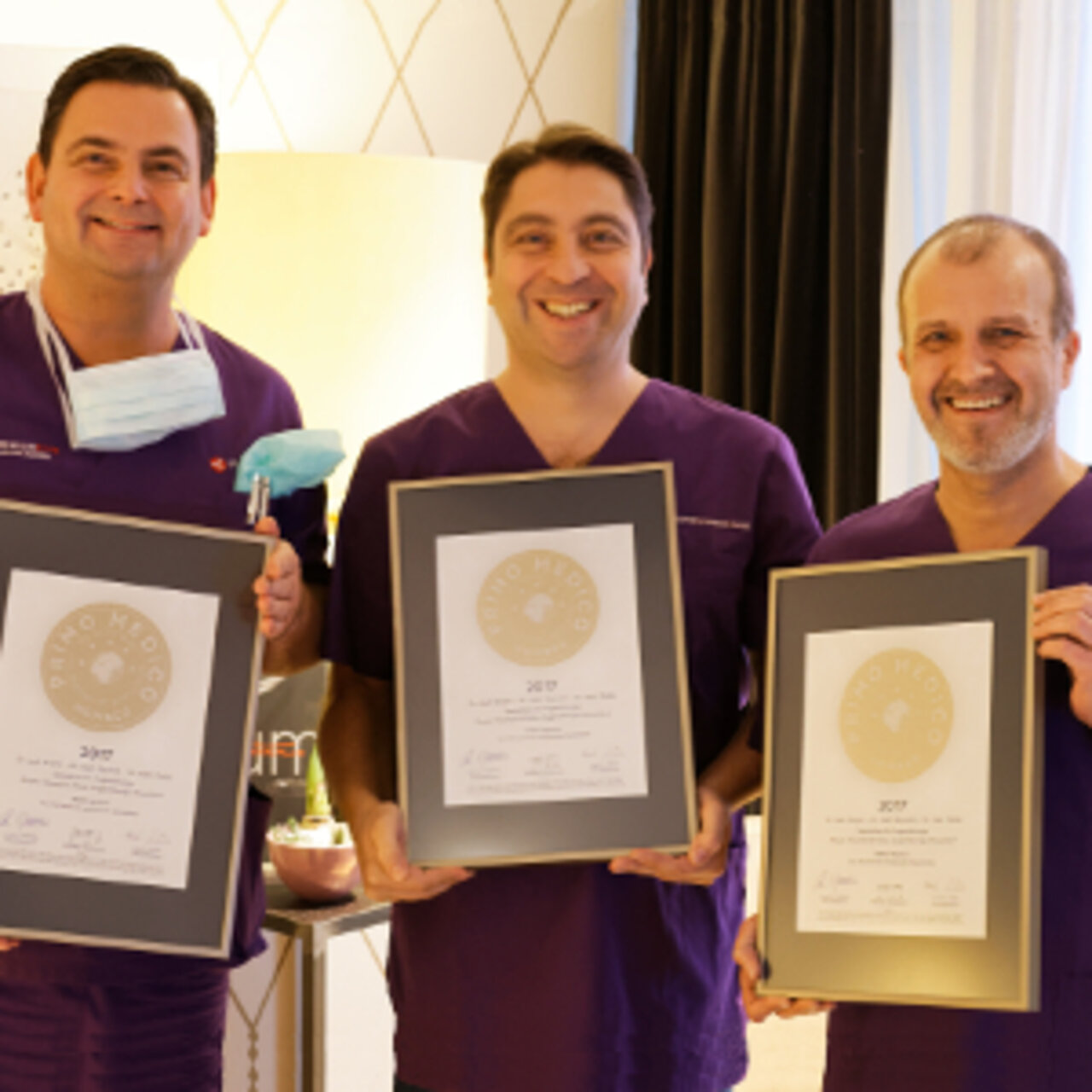Specialists in DMEK
4 Specialists found
Information About the Field of DMEK
What Does DMEK Mean?
DMEK means "Descemet membrane endothelial keratoplasty." DMEK is a relatively new surgical procedure used for diseases of the corneal endothelium. The corneal endothelium is the innermost layer of the cornea of the eye. In DMEK, this layer is replaced with a donor graft.
Corneal transplants for the treatment of corneal diseases have been performed for over 100 years. For a long time, the so-called penetrating keratoplasty was also used for diseases of the cornea's innermost layer. In this procedure, the defective cornea is replaced with a complete donor cornea. However, in recent years, surgical methods have been developed in which not all layers of the cornea are replaced, but only the diseased innermost layers. First, the DSAEK (Descemet stripping automated endothelial keratoplasty) was developed, and DMEK followed in 2006.
The cornea consists of five layers. The epithelial layer is on the outside, followed by Bowman's layer, stroma, Descemet's membrane, and the endothelium as the innermost layer. In DSAEK, the endothelium, Descemet's membrane, and part of the stroma are transplanted; in DMEK, only the endothelium and Descemet's membrane are transplanted.
DMEK is now considered the gold standard for treating corneal endothelial disease.
Who Is Eligible for DMEK?
DMEK is an option for people with the corneal endothelial disease. Common reasons for DMEK include Fuchs' endothelial atrophy and pseudophakic bullous keratopathy.
Fuchs endothelial dysplasia is a hereditary dysfunction of the corneal endothelium. This dysfunction causes corneal edema, which means fluid accumulates in the layers of the cornea. Patients have blurred vision and are sensitive to light. The corneal opacity caused by the edema is still reversible. At this stage of the disease, DMEK is an option. With intact donor endothelium, the fluid can be "pumped out" of the layers of the cornea. If the disease is not treated, irreversible changes of the corneal stroma will occur in the later course of the disease. Then DMEK should no longer be performed because these changes remain despite surgery.
Pseudophakic bullous keratopathy might develop after cataract surgery if the corneal endothelium was damaged during the procedure. As a result, blisters form in the outer corneal layer, the corneal epithelium. In this case, DMEK is also suitable to replace the damaged endothelium.
Other less common reasons for DMEK are graft failure after penetrating keratoplasty, endothelial damage from other eye surgeries, or pseudoexfoliation syndrome.
As in Fuchs' endothelial dystrophy, DMEK is unsuitable if scarring changes in the deep corneal stroma have already occurred due to the diseases.
The Procedure of the Surgery
The surgery can be performed under general or local anesthesia. The procedure itself is very short; it requires only a few millimeter incisions in the cornea, through which the surgeon passes special instruments. The surgeon first fills the anterior chamber of the eye with air. He then removes the Descemet's membrane with the endothelium. The donor graft is only a few microns thick and is curled up in a culture medium before transplantation. After removing the air, the physician inserts the graft into the eye's anterior chamber with an artificial lens injector while adding fluid. An artificial lens injector is a type of syringe used to place artificial lenses into the eye. Then, by carefully tapping, the surgeon unrolls the graft and places it in the correct position. When the graft is unrolled and in the right position, an air bubble is placed behind it. This presses the graft into place. Suturing is not necessary.
Patients must lie on their backs a lot for two to three days after the procedure. This is important so that the air bubble is appropriately aligned, and the graft can press on optimally until it becomes ingrown.
After surgery, patients need eye drops every hour for a week. The eye drops contain prednisolone and reduce the risk of rejection. In addition, eye drops with an antibiotic are given to prevent infection. After the first week, patients must take eye drops five times a day. Over the next few months, the daily usage of eye drops is gradually reduced to once a day. Eye drops are needed for at least two years.
What Is the Experience with DMEK?
After introducing DSAEK and DMEK, these surgical techniques soon proved superior to penetrating keratoplasty for endothelial disease. The advantages are the better functional outcome, faster visual improvement, lower risk of bleeding and infection, less rejection, and less astigmatism after surgery.
Visual improvement occurs particularly quickly with DMEK compared to the other methods. However, the degree of visual improvement achieved in patients with DMEK after four months is not seen until after 18 months with DSAEK and after two years with penetrating keratoplasty.
DMEK also performs better in visual acuity compared to DSAEK. More than half of the patients achieve visual acuity of 80 percent or more six months after surgery. This is a significantly higher proportion than with DSAEK.
Are There Alternatives?
In some cases, a different surgical method may be more appropriate. For example, in certain pre-existing conditions of the eye, for example, iris defects, a lensless eye, a very shallow or very deep anterior chamber, it is more difficult to unroll the graft and place it in the correct position.
DSAEK can be considered as an alternative surgical method. While in DMEK, the graft is less than 20 micrometers thick, in DSAEK, the graft is 100 to 200 micrometers thick. This makes transplant deployment easier with this method.
Most patients are also satisfied with DSAEK. However, less than 10 percent of patients achieve more than 80 percent visual acuity after six months. This may be because differently oriented stromal fibers meet since part of the stroma is also transplanted.
If the disease affects the endothelium and there are already significant scarring changes in the stroma, penetrating keratoplasty is still the best surgical method. This method is also more suitable than DMEK in cases of severe astigmatism.
What Are the Risks?
Possible complications of DMEK are graft failure, graft detachment, an increase of intraocular pressure, refractive change, and macular edema.
Graft failure is more common than penetrating keratoplasty. This also means that a second procedure is needed more often. In most cases, this involves re-injection of air when the position of the graft changes. It can also happen that the graft rolls in again at the edges, in which case another air injection frequently becomes necessary.
The probability of a rejection reaction is about one to three percent within the first two years and is significantly smaller than with the other two surgical methods.
Which Doctors and Clinics Are Specialized in DMEK?
Every patient who needs a doctor wants the best medical care. Therefore, the patient is wondering where to find the best clinic. As this question cannot be answered objectively and a reliable doctor would never claim to be the best one, we can only rely on the doctor's experience.
We will help you find an expert for your condition. All listed doctors and clinics have been reviewed by us for their outstanding specialization in the field of DMEK and are awaiting your inquiry or treatment request.
Sources:
- Heinzelmann S. et al. (2016). Outcomes of Descemet membrane endothelial keratoplasty, Descemet stripping automated endothelial keratoplasty, an penetrating keratoplasty from a single centre study. Graefes Arch Clin Exp Ophthalmol (2016) 254:515-522
- Maier P. et al. (2013). Hauchdünne Hornhauttransplantate – schnelle und gute Sehschärfenerholung. Deutsches Ärzteblatt, Jg. 110, Heft 21, 24. Mai 2013
- Matthaei M. et la. (2018). Technik der "Descemet membrane endothelial keratoplasty "(DMEK). Ophtalmologe 2018, 115:778-784
- Seitz B. et al. (2020). „Descemet membrane endothelial keratoplasty“ DMEK – Spender und Empfänger Schritt für Schritt. Ophtalmologe 2020, 117:811-828



